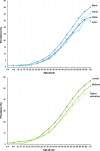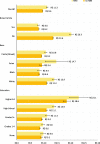Racial and socioeconomic disparities in multimorbidity and associated healthcare utilisation and outcomes in Brazil: a cross-sectional analysis of three million individuals
- PMID: 34210313
- PMCID: PMC8252284
- DOI: 10.1186/s12889-021-11328-0
Racial and socioeconomic disparities in multimorbidity and associated healthcare utilisation and outcomes in Brazil: a cross-sectional analysis of three million individuals
Abstract
Background: Evidence is limited on racial/ethnic group disparities in multimorbidity and associated health outcomes in low- and middle-income countries hampering effective policies and clinical interventions to address health inequalities.
Methods: This study assessed race/ethnic and socioeconomic disparities in the prevalence of multimorbidity and associated healthcare utilisation, costs and death in Rio de Janeiro, Brazil. A cross-sectional analysis was carried out of 3,027,335 individuals registered with primary healthcare (PHC) services. Records included linked data to hospitalisation, mortality, and welfare-claimant (Bolsa Família) records between 1 Jan 2012 and 31 Dec 2016. Logistic and Poisson regression models were carried out to assess the likelihood of multimorbidity (two or more diagnoses out of 53 chronic conditions), PHC use, hospital admissions and mortality from any cause. Interactions were used to assess disparities.
Results: In total 13,509,633 healthcare visits were analysed identifying 389,829 multimorbid individuals (13%). In adjusted regression models, multimorbidity was associated with lower education (Adjusted Odds Ratio (AOR): 1.26; 95%CI: 1.23,1.29; compared to higher education), Bolsa Família receipt (AOR: 1.14; 95%CI: 1.13,1.15; compared to non-recipients); and black race/ethnicity (AOR: 1.05; 95%CI: 1.03,1.06; compared to white). Multimorbidity was associated with more hospitalisations (Adjusted Rate Ratio (ARR): 2.75; 95%CI: 2.69,2.81), more PHC visits (ARR: 3.46; 95%CI: 3.44,3.47), and higher likelihood of death (AOR: 1.33; 95%CI: 1.29,1.36). These associations were greater for multimorbid individuals with lower educational attainment (five year probability of death 1.67% (95%CI: 1.61,1.74%) compared to 1.13% (95%CI: 1.02,1.23%) for higher education), individuals of black race/ethnicity (1.48% (95%CI: 1.41,1.55%) compared to 1.35% (95%CI: 1.31,1.40%) for white) and individuals in receipt of welfare (1.89% (95%CI: 1.77,2.00%) compared to 1.35% (95%CI: 1.31,1.38%) for non-recipients).
Conclusions: The prevalence of multimorbidity and associated hospital admissions and mortality are greater in individuals with black race/ethnicity and other deprived socioeconomic groups in Rio de Janeiro. Interventions to better prevent and manage multimorbidity and underlying disparities in low- and middle-income country settings are needed.
Keywords: Brazil; Chronic conditions; Hospitalisations; Middle-income country; Mortality; Multimorbidity; Utilisation.
Conflict of interest statement
BD was Undersecretary of Health Promotion, Surveillance, and Primary Care at the Secretaria Municipal de Saúde, Rio de Janeiro when this project was conceived.
VS is a Coordinator of Health Situation Analysis in the Health Surveillance Department, at the Secretaria Municipal de Saúde, Rio de Janeiro.
All other authors declare they have no conflicts of interest.
Figures




Similar articles
-
Racial inequalities in mental healthcare use and mortality: a cross-sectional analysis of 1.2 million low-income individuals in Rio de Janeiro, Brazil 2010-2016.BMJ Glob Health. 2023 Dec 2;8(12):e013327. doi: 10.1136/bmjgh-2023-013327. BMJ Glob Health. 2023. PMID: 38050408 Free PMC article.
-
Primary healthcare expansion and mortality in Brazil's urban poor: A cohort analysis of 1.2 million adults.PLoS Med. 2020 Oct 30;17(10):e1003357. doi: 10.1371/journal.pmed.1003357. eCollection 2020 Oct. PLoS Med. 2020. PMID: 33125387 Free PMC article.
-
Social determinants of health and emergency department visits among older adults with multimorbidity: insight from 2010 to 2018 National Health Interview Survey.BMC Public Health. 2024 Apr 24;24(1):1153. doi: 10.1186/s12889-024-18613-8. BMC Public Health. 2024. PMID: 38658873 Free PMC article.
-
Approaches to Comparing the Impact of Socioeconomic Disadvantage on Acute Myocardial Infarction Care Within and Across Countries: A Scoping Review.Can J Cardiol. 2024 Jun;40(6):1135-1145. doi: 10.1016/j.cjca.2024.03.013. Epub 2024 Mar 26. Can J Cardiol. 2024. PMID: 38548014 Free PMC article.
-
Multimorbidity matters in low and middle-income countries.J Multimorb Comorb. 2022 Jun 16;12:26335565221106074. doi: 10.1177/26335565221106074. eCollection 2022 Jan-Dec. J Multimorb Comorb. 2022. PMID: 35734547 Free PMC article. Review.
Cited by
-
Clinical, epidemiological characteristics and mortality of pregnant and postpartum women associated with COVID-19 in Brazil: cohort study.Rev Bras Ginecol Obstet. 2024 Jun 27;46:e-rbgo52. doi: 10.61622/rbgo/2024rbgo52. eCollection 2024. Rev Bras Ginecol Obstet. 2024. PMID: 38994462 Free PMC article.
-
Social determinants of gastrointestinal malformation mortality in Brazil: a national study.World J Pediatr Surg. 2024 May 21;7(2):e000759. doi: 10.1136/wjps-2023-000759. eCollection 2024. World J Pediatr Surg. 2024. PMID: 38779587 Free PMC article.
-
Associations between primary healthcare and infant health outcomes: a cohort analysis of low-income mothers in Rio de Janeiro, Brazil.Lancet Reg Health Am. 2023 May 25;22:100519. doi: 10.1016/j.lana.2023.100519. eCollection 2023 Jun. Lancet Reg Health Am. 2023. PMID: 37274550 Free PMC article.
-
The impact of COVID-19 on maternal death and fetal death, a cohort study in Brazil.PLoS One. 2023 Aug 17;18(8):e0290343. doi: 10.1371/journal.pone.0290343. eCollection 2023. PLoS One. 2023. PMID: 37590217 Free PMC article.
-
Expansion of primary healthcare and emergency hospital admissions among the urban poor in Rio de Janeiro Brazil: A cohort analysis.Lancet Reg Health Am. 2022 Sep 5;15:100363. doi: 10.1016/j.lana.2022.100363. eCollection 2022 Nov. Lancet Reg Health Am. 2022. PMID: 36778075 Free PMC article.
References
-
- Global Burden of Disease Results Tool [http://ghdx.healthdata.org/gbd-results-tool]. Accessed 17 Apr 2020.
-
- Bloom DE, Cafiero E, Jané-Llopis E, Abrahams-Gessel S, Bloom LR, Fathima S, Feigl AB, Gaziano T, Hamandi A, Mowafi M. Program on the global demography of Aging. 2012. The global economic burden of noncommunicable diseases.
-
- Nolte E, McKee M: Caring for people with chronic conditions: a health system perspective: McGraw-Hill International; 2008.
Publication types
MeSH terms
Grants and funding
- MR/P014593/1/MRC_/Medical Research Council/United Kingdom
- WT_/Wellcome Trust/United Kingdom
- MR/T027517/1/MRC_/Medical Research Council/United Kingdom
- 303295/2019-8/Instituto Nacional de Ciência e Tecnologia da Criosfera
- E-26/200.003/2019/Fundação Carlos Chagas Filho de Amparo à Pesquisa do Estado do Rio de Janeiro
LinkOut - more resources
Full Text Sources
Research Materials

